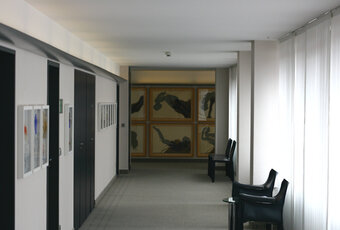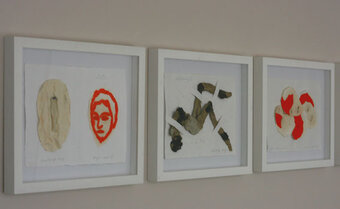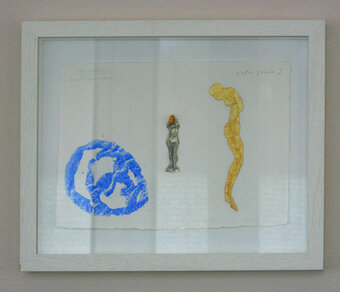Jürgen Brodwolf
October 21 to December 6, 2013: Jürgen Brodwolf, >Works from the series "Wunde" and "Cato"<
Photo: Gottfried Junker
Jürgen Brodwolf, born in Dübendorf near Zurich in 1932, became famous for his installations and especially for the "Tubenfigur" (tube figure). The inventor of this unique and highly variable sculpture writes: "We remember the enormous ability from our childhood to project or read human and animal beings into or out of typical shaped stones, wood, branches, etc. to project human and animal creatures into or read them out of typical shapes. A handful of driftwood by the river, broken tree branches, rotten pieces of wood in the forest are transformed into father, mother, prince, king, witch, devil, dwarf. The stories and images from the world of fairy tales and my own overflowing imagination were played and lived with these figures. This is the origin of my later tube figure."
Brodwolf now lives and works in Kandern in South Baden.

Greenhouses on the Neckar, landscape installation, 1985

Tube figure, photo: Bernhard Strauss
"Can the unimaginable be represented?"
In March 1994, Brodwolf was in Theresienstadt: "For the first time, I set foot on the grounds of a former concentration camp to take part in a meeting about the planned exhibition UZKOST TELA (Body in Agony). A leaden heaviness hangs over the camp. The mass and individual cells with their bunks, benches and tables are swept clean and empty - as if prepared for the next transport." The exhibition in Theresienstadt opens in June. According to the artist, the large-format sheets from the "Wound" cycle look "like rock or wall drawings". There is no doubt that an oppressive mood sets in as you walk along the corridor at the back. The maltreated bodies accompany you mercilessly from one end to the other.
The Cato cycle also deals with the horrors of the Nazi era. The impressive paper reliefs and collages from 2008 are intended not only to recall Cato Bontje van Beek, but - much more importantly - to keep her alive for the present and the future.
Cato, born in Bremen in 1920, spent her childhood and youth in the Worpswede artists' colony. In 1941, she joined the resistance against the Hitler regime. One year later, she was arrested by the Gestapo. The Reich court martial sentenced her to death for high treason in 1943. In the same year, she was executed in Plötzensee.
Cato's dream, 2008
In 2008 and 2009, Brodwolf worked on this cycle - inspired by the publication by Hermann Vinke: Cato Bontje van Beek. "I did not beg for my life". A portrait.
In 2009, Jürgen Brodwolf published his book about Cato with Radius-Verlag in Stuttgart: Cato lives on. With texts by Cato Bontjes van Beek, Heidelore Kluge, Hermann Vinke, Heinrich Scheel, Tim Bontjes van Beek, Marta Husemann, Tatjana Ahlers-Hestermann, Marianne von Randow, Hans Schultze-Ritter and Lew Kopelew.





